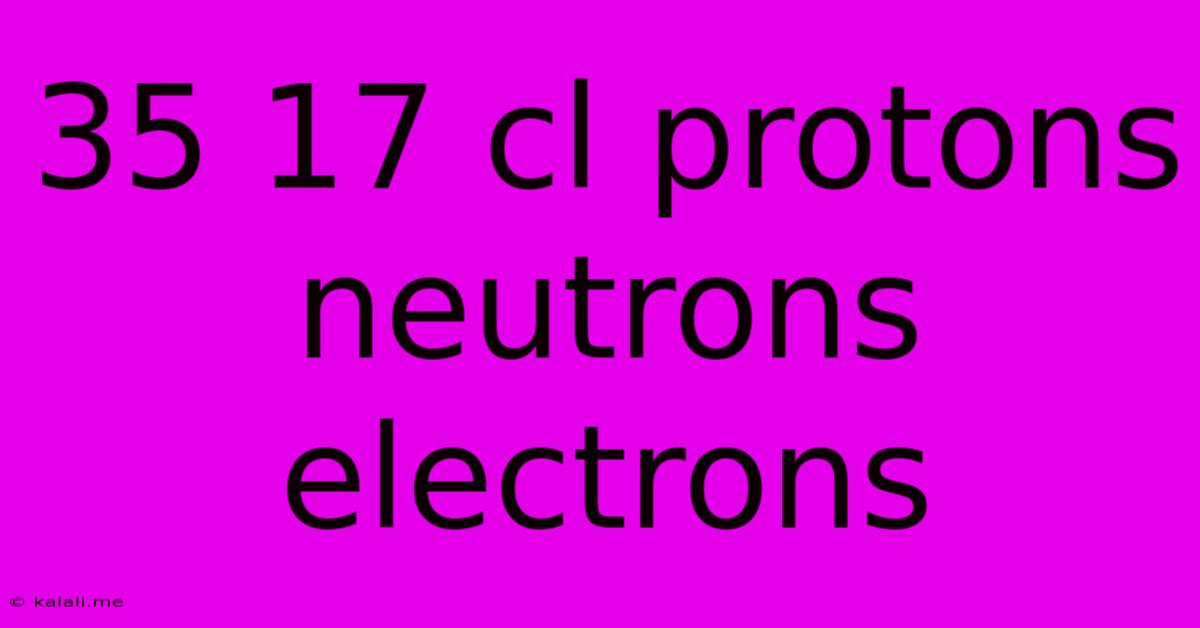35 17 Cl Protons Neutrons Electrons
Kalali
Jun 16, 2025 · 3 min read

Table of Contents
Understanding the Composition of an Atom: 35, 17, and the Role of Protons, Neutrons, and Electrons
This article explores the fundamental structure of an atom, focusing on the significance of protons, neutrons, and electrons using the example of an atom with 35, 17. Understanding atomic structure is crucial in various fields like chemistry, physics, and materials science. We'll delve into how these subatomic particles contribute to an atom's identity and properties.
An atom, the basic building block of matter, is composed of three primary subatomic particles: protons, neutrons, and electrons. The numbers 35 and 17, usually presented as (35, 17), refer to the mass number (A) and the atomic number (Z) respectively. Let's break down their meaning:
Atomic Number (Z): The Identity of an Element
The atomic number (Z) represents the number of protons in an atom's nucleus. Protons carry a positive charge (+1). In our example, Z = 17, indicating the atom has 17 protons. This number uniquely identifies the element. An element with 17 protons is chlorine (Cl). The number of protons determines the element's chemical properties and its position on the periodic table.
Mass Number (A): Protons and Neutrons Combined
The mass number (A) is the total number of protons and neutrons found in the atom's nucleus. Neutrons carry no charge (neutral). In this case, A = 35. Since we know there are 17 protons, the number of neutrons is calculated as:
Number of neutrons = A - Z = 35 - 17 = 18 neutrons.
Therefore, this chlorine atom contains 18 neutrons. The number of neutrons can vary for the same element, resulting in isotopes. Isotopes are atoms of the same element with the same number of protons but a different number of neutrons.
Electrons: Orbiting the Nucleus
Electrons are negatively charged particles (-1) that orbit the nucleus in electron shells or energy levels. In a neutral atom, the number of electrons is equal to the number of protons. Therefore, this chlorine atom (Z=17) also has 17 electrons. These electrons are responsible for the atom's chemical behavior and interactions with other atoms. The arrangement of electrons in these shells determines the atom's reactivity and its ability to form chemical bonds.
Isotopes and Chlorine
As mentioned earlier, the variation in neutron number leads to isotopes. Chlorine has two naturally occurring isotopes: Chlorine-35 (¹⁷Cl) and Chlorine-37 (¹⁷Cl). Chlorine-35, with 17 protons and 18 neutrons, is the more abundant isotope. The existence of isotopes explains why the average atomic mass of chlorine on the periodic table is not a whole number.
Conclusion: The Interplay of Subatomic Particles
The numbers 35 and 17 provide a concise description of a specific chlorine atom's composition. The interplay between the number of protons, neutrons, and electrons dictates the atom's identity, mass, and chemical properties. Understanding this fundamental atomic structure is essential for comprehending the behavior of matter at a molecular and macroscopic level. Further exploration into electron configuration and chemical bonding can deepen your understanding of how these subatomic particles influence the properties of different elements and compounds.
Latest Posts
Latest Posts
-
How To Create Clickable Image In Html
Jun 16, 2025
-
What Are The Factors Of 121
Jun 16, 2025
-
What Is A Theme Of The Passage
Jun 16, 2025
-
A Company That Provides Access To The Internet
Jun 16, 2025
-
Which Word Is Closest In Meaning To The Underlined Word
Jun 16, 2025
Related Post
Thank you for visiting our website which covers about 35 17 Cl Protons Neutrons Electrons . We hope the information provided has been useful to you. Feel free to contact us if you have any questions or need further assistance. See you next time and don't miss to bookmark.